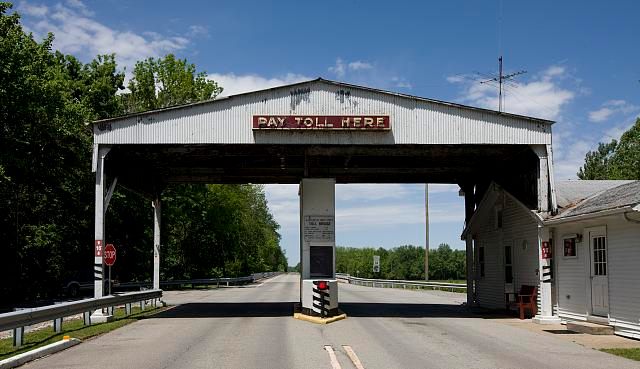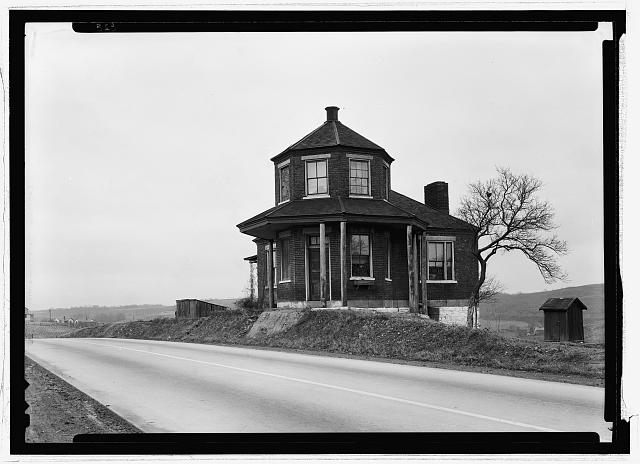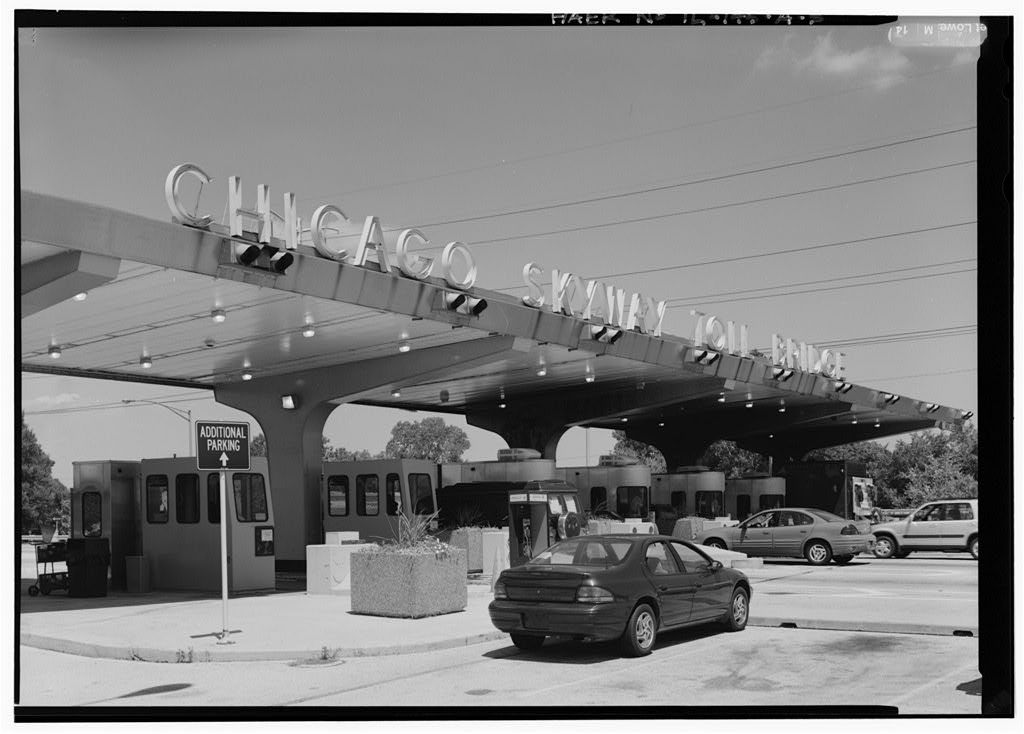The Case for Preserving the 20th Century Tollbooth
When highways were marvels, toll plazas were well designed.

Massachusetts is destroying its toll plazas. By the end of this year, every single one on the Massachusetts Turnpike will have been demolished. Drivers will still pay to use the road—they will zoom through the metal arches of electronic tolling infrastructure—but the routine of slowing down, stopping to grab a ticket, and waiting for the barrier to rise will be gone.
Massachusetts is being more aggressive than most places about sweeping away its old tolling infrastructure, but all across the country, from New York to Florida, Texas to California, road authorities are switching to all-electronic tolling. While it’s too soon to declare the tollbooth dead, it’s easy to imagine a future in which roads are unencumbered by boxy plazas and simple gates.
If toll plazas are an endangered species of infrastructure, though, no one seems worried. Most of the time, when familiar landscapes are altered, people who have become accustomed to them kick up a fuss. But in this case there’s little love lost. When toll plazas are gone, will anyone miss them? Will future generations think ours shortsighted for letting this piece of history be demolished? Is there anything about tollbooths worth preserving?

It’s not that Americans are entirely lacking in nostalgia for toll-collection infrastructure. Along the historic roads of the United States, it’s possible to find toll houses dating back to the 1830s. “Especially when you go to the 19th century, there’s more interest in the toll houses than the road itself,” says Paul Daniel Marriott, who specializes in preservation planning for historic roads. The original toll houses of the National Road, for instance, were built by the federal government before it handed over operation of the country’s first major artery—from Cumberland, Maryland, to Vandalia, Illinois—to the states. Each toll house had a hexagonal second floor with windows on all six sides, so the toll keeper could look up and down the road for travelers.
There is a toll booth installed in 1940 on the Pennsylvania Turnpike preserved at the State Museum of Pennsylvania. But it’s rare for preservationists to pay attention to more modern toll structures. A representative of the Society for Commercial Archaeology, which is devoted to preserving motels, neon signs, and other aspects of the 20th century’s “commercial landscape,” asked around but could find no member who’d done any work on tollbooths. In fact, there may have been only one major preservation effort to save a 20th century toll plaza—a 1988 campaign to save the tollbooths of Connecticut’s Merritt Parkway.

As high-speed roads go, the Merritt is extraordinary pleasant, a leafy, tree-heavy drive that meanders under dozens of bridges, each with a unique design. The parkway, which was completed in 1940, was meant to be more than “another highway catering to the burgeoning commuter population,” writes Bruce Radde in The Merritt Parkway. “It was lauded by design professionals and critics for its excellent engineering, it respect for the natural environment, and its inherent beauty.”
The tollbooths were added to the parkway before its second half was finished, and were designed by George Dunkelberger, who was also responsible for the road’s iconic bridges. The booths looked like log cabins that might not be out of place in a National Park. Like most newly imposed tolls, this one was celebrated by public officials and met with some public skepticism: A contemporary news story describes how one Matthew E. Scully sped through a new toll booth at 30 miles per hour and tossed his 10-cent fare at the attendant. (He was arrested immediately by a police officer waiting on the other side.)
Almost 50 years later, though, after highways had become bigger and faster, those tollbooths began to evoke a certain nostalgia. “I had fond childhood memories of Sunday drives on the Merritt, slowing down and dropping the dime into the little log cabin,” says David Carris, who was working at the time as a preservationist in New Haven, Connecticut.
By 1988, parts of the original Merritt Parkway had been converted into more modern interstate, and the rest was under threat. “You could see it was already being chipped away,” Carris says. When the Merritt tollbooths were slated for removal, he and a coalition of other preservationists decided to fight for them. They began trying to convince the government to keep demolition crews at bay and looking for museums or parks that might agree to adopt one of the old toll plazas.

They didn’t encounter opposition, exactly. “If somebody wants to preserve [the tollbooths], I have no problem with that … Just get them off the darn highway,” the president of a commuters’ group told the Hartford Courant. The government was also happy to let preservationists have the tollbooths. Carris, along with the Committee to Save the Merritt Parkway and other preservation organizations, found a home for part of the Merritt’s first toll plaza at the Henry Ford Museum, in Dearborn, Michigan. Another tollbooth went to Connecticut’s Boothe Memorial Park, an eclectic collection on the site of the Boothe family estate. The campaign was, overall, a success.
Often, in cases like this, the leader of a successful preservation project will hear from other people waging similar campaigns. But as far as Carris knows, this is the only preservation effort of its kind. “I’ve never heard of anyone else trying to save tollbooth,” says Carris. “They disappear, and you don’t even really notice it.”

The effort to save the Merritt tollbooths wasn’t only about the actual toll infrastructure. Carris and the rest of the coalition saw their campaign as part of a longer fight to save the historic landscape of the Merritt from being folded into a modern highway. To the extent that tollbooths catch preservationists’ interest at all, it’s often because they’re part of larger projects.
“Many toll facilities were associated with significant engineering undertakings,” says Marriott, the historic road specialist. “It’s there where you find the higher level of investment and tollbooths that are part of the overall design and aesthetic.” One toll plaza that caught his eye, for instance, is the one on the Golden Gate Bridge, where not just the bridge but the lighting, the booths, and other details were carefully considered. When people like him try to capture a breath of the past, these details help complete the picture, he says.
Tollbooths, though, are so overlooked that they’re usually badly maintained. Both Carris and Marriott mentioned the New York State Thruway toll plaza—a “piece of international modernist infrastructure strung out over I-95,” in Carris’ words—as striking and worthy of more attention. “They’re not taking care of it,” says Marriott. “It’s really shabby. There’s missing letters. It’s not been cleaned or cared for, for a long time.”
The Thruway toll plaza represents a recent-enough past that few people probably think of it as in need of preservation. Further, when infrastructure is badly cared for, it becomes less noticeable and attractive—and therefore less likely to receive the outpouring of affection that preservation campaigns often depend on.

Even unloved tollbooths, though, may one day be missed if they disappear. “Why care about tollbooths? I can make the case,” says Carris. “They make you stop. We have a 12,000-year history of city-making and one of the unique experiences of entering and leaving a gated city was going through the city gates. In a way, there was a ritual associated with tollbooths of entering and leaving the city, and it’s an important human experience that we’re losing in this age of E-ZPass.” Tollbooths help mark the boundaries of place, and they can be monuments to human achievement.
“When the interstate system was so magnificent and futuristic—the Thruway tollbooth captures that,” says Marriott. Today, our highways are more likely to be worn and in need of repair. Maybe it would be worthwhile to remember the moment when we cared enough about them to make even the toll plazas a little bit magnificent.








Follow us on Twitter to get the latest on the world's hidden wonders.
Like us on Facebook to get the latest on the world's hidden wonders.
Follow us on Twitter Like us on Facebook